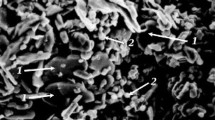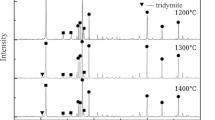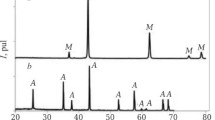It is established that the structure of the solid phase of a material and the porous structure evolve in different directions: if the coordination number in the solid phase of a material increases as porosity decreases, then in a porous structure the number decreases. A universal, quite strict, structural model is proposed for high- and low-porosity ceramic materials which are obtained by pressing and using powdered, burnable, monodisperse additives.




Similar content being viewed by others
References
A. A. Bateev and V. A. Bateev, Composite Materials [in Russian], Izd. NGTU, Novosibirsk (2002).
L. I. Kheifets and A. V. Neimark, Multiphase Processes in Porous Materials [in Russian], Khimiya, Moscow (1982).
B. I. Shklovksii and A. L. Éfros, Electronic Properties of Doped Semiconductors [in Russian], Nauka, Moscow (1979).
G. N. Dul’nev and Yu. P. Zarichnyak, Heat Conduction in Mixtures and Composite Materials [in Russian], Énergiya, Leningrad (1974).
Yu. N. Kryuchkov, Structure and Nonlinear Structural Effects in Permeable and Composite Materials [in Russian], GGKhPI, Gzhel’ (2006).
S. Kochevets, J. Backmaster, and T. Jacson, “The random packing of heterogeneous propellant combustion,” J. Propulsion and Power, 39(4), 678–684 (2001).
J. Ziman, Models of Disorder [Russian translation], Mir, Moscow (1982).
E. Arzt, “The influence of an increasing particle coordination on the densification of spherical powders,” Acta Metall., 30(10), 1883–1890 (1982).
D. P. Volkov, “Permeability of porous materials,” Inzh.-Fiz. Zh., 16(3), 421–426 (1981).
V. N. Antsiferov, A. P. Kunevich, V. A. Basanov, et al., “Electric resistance and heat conduction of high-porosity permeable materials,” Poroshk. Metall., No. 8, 87–90 (1988).
Author information
Authors and Affiliations
Corresponding author
Additional information
Translated from Steklo i Keramika, No. 10, pp. 19 – 23, October, 2012.
Rights and permissions
About this article
Cite this article
Kryuchkov, Y.N. Structural model of materials obtained by pressing and using burnable additives. Glass Ceram 69, 337–341 (2013). https://doi.org/10.1007/s10717-013-9474-0
Published:
Issue Date:
DOI: https://doi.org/10.1007/s10717-013-9474-0




